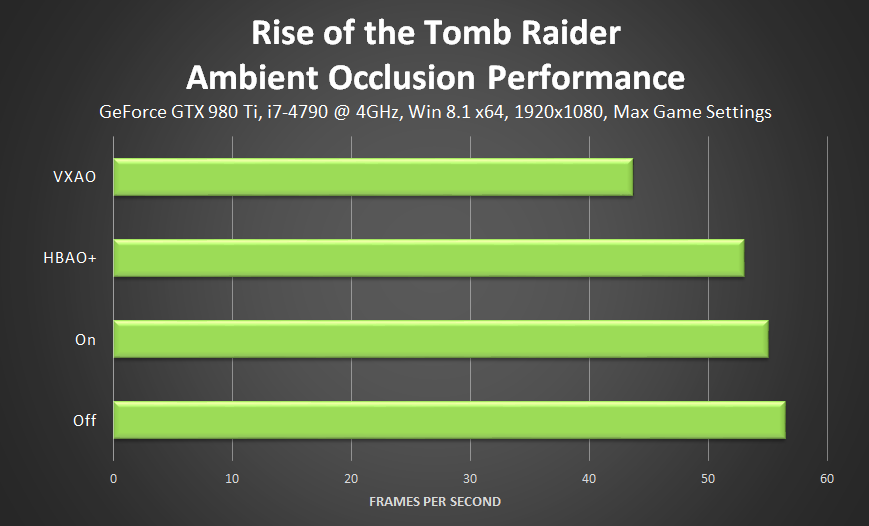Install the app
How to install the app on iOS
Follow along with the video below to see how to install our site as a web app on your home screen.
Note: This feature may not be available in some browsers.
You are using an out of date browser. It may not display this or other websites correctly.
You should upgrade or use an alternative browser.
You should upgrade or use an alternative browser.
Rise of the Tomb Raider [PC]
- Thread starter Clukos
- Start date
I am not sure whether the author of the video had applied VXAO at all
http://images.nvidia.com/geforce-co...-comparison-008-nvidia-vxao-vs-hbao-plus.html
http://images.nvidia.com/geforce-co...-comparison-009-nvidia-vxao-vs-hbao-plus.html
http://images.nvidia.com/geforce-co...-comparison-010-nvidia-vxao-vs-hbao-plus.html
http://images.nvidia.com/geforce-co...-comparison-011-nvidia-vxao-vs-hbao-plus.html
http://images.nvidia.com/geforce-co...-comparison-013-nvidia-vxao-vs-hbao-plus.html
http://images.nvidia.com/geforce-co...-comparison-014-nvidia-vxao-vs-hbao-plus.html
I love people these days
OIT - Meh
GPU Rigid bodies - Meh
Voxel Space Cone Tracing AO - Meh
Frustum Traced Shadows - Meh
FLEX - meh
+5% performance gains in a couple of CPU limited cases with DX12 compared to turtle like AMD DX11 driver -- hurray, best thing ever, 10 out of 10, still > 30 FPS with 4K, because draw calls have nothing to do with it
http://images.nvidia.com/geforce-co...-comparison-008-nvidia-vxao-vs-hbao-plus.html
http://images.nvidia.com/geforce-co...-comparison-009-nvidia-vxao-vs-hbao-plus.html
http://images.nvidia.com/geforce-co...-comparison-010-nvidia-vxao-vs-hbao-plus.html
http://images.nvidia.com/geforce-co...-comparison-011-nvidia-vxao-vs-hbao-plus.html
http://images.nvidia.com/geforce-co...-comparison-013-nvidia-vxao-vs-hbao-plus.html
http://images.nvidia.com/geforce-co...-comparison-014-nvidia-vxao-vs-hbao-plus.html
I love people these days
OIT - Meh
GPU Rigid bodies - Meh
Voxel Space Cone Tracing AO - Meh
Frustum Traced Shadows - Meh
FLEX - meh
+5% performance gains in a couple of CPU limited cases with DX12 compared to turtle like AMD DX11 driver -- hurray, best thing ever, 10 out of 10, still > 30 FPS with 4K, because draw calls have nothing to do with it
I am not sure whether the author of the video had applied VXAO at all
http://images.nvidia.com/geforce-co...-comparison-008-nvidia-vxao-vs-hbao-plus.html
http://images.nvidia.com/geforce-co...-comparison-009-nvidia-vxao-vs-hbao-plus.html
http://images.nvidia.com/geforce-co...-comparison-010-nvidia-vxao-vs-hbao-plus.html
http://images.nvidia.com/geforce-co...-comparison-011-nvidia-vxao-vs-hbao-plus.html
http://images.nvidia.com/geforce-co...-comparison-013-nvidia-vxao-vs-hbao-plus.html
http://images.nvidia.com/geforce-co...-comparison-014-nvidia-vxao-vs-hbao-plus.html
It looks vastly better in those shots to me. Surprisingly so. These are the first comparisons I've seen on my monitor, everything else has been on my phone, so from reading the comments I'd expected a marginally noticeable difference. But this is huge IMO.

"March 2016 NVIDIA Voxel Ambient Occlusion (VXAO) Update: Derived from our Voxel Global Illumination technology, VXAO is a new cutting-edge Ambient Occlusion technique that improves upon HBAO+ to deliver the most realistic Ambient Occlusion shadowing seen to date in games.
With VXAO, occlusion and lighting information is gathered from a ‘world space’ voxel representation of the scene, which takes into account a large area around the viewer. Included in this voxelization are objects and details currently invisible to the viewer, and those behind the viewer, too. The result is scene-wide Ambient Occlusion shadowing, instead of ‘screen space’ shadowing based on what you can currently see. This allows AO shadows to be cast into a scene from objects near to the player but just outside of their view, and from occluded objects in the distance large enough to affect the appearance of the scene.
In addition, VXAO’s precision and accuracy enables significantly improved Ambient Occlusion shadowing in detailed in-game environments. This is particularly evident in Crystal Dynamics’ Rise of the Tomb Raider, the first game to feature VXAO. As demonstrated below in our interactive comparisons, VXAO dramatically improves the quality of Ambient Occlusion shadowing in the game’s object and geometry-filled locations.
In this first set of comparisons, VXAO's precision is exemplified. Detailed objects spread across several layers are accurately and richly shadowed, light being cast and reflected in the room is accurately accounted for, and new AO shadows rendered."
http://www.geforce.com/whats-new/gu...b-raider-ambient-occlusion-nvidia-vxao-update
It seems like VXAO isn't applied in screen space, could easily explain the performance impact. It definitely is more accurate than typical SSAO and HBAO+ though, wondering how it compares against Epics own DFAO

Last edited:
Offcouse it's not a screen space method, that's why it's called Voxel AO, Voxels are 3D by definition, but tracing thru the 3D voxel structure is done on per depth buffer's pixel basis, for each depth buffer pixel there are several cone traces in 256^3 Voxel structure in different directions to gather an occlusion factor, that's why the method is not cheap, but thanks to the regularity of voxels and cone tracing it's perfectly temporary stable, lacks any pixel noises, and much cheaper in comparison with path tracingIt seems like VXAO isn't applied in screen space, could easily explain the performance impact. It definitely is more accurate than typical SSAO and HBAO+ though, wondering how it compares against Epics own DFAO
D
Deleted member 13524
Guest
Let me guess, VXAO is extremely dependent on geometry performance 
D
Deleted member 13524
Guest
Oh then it's extremely dependent on a feature that is exclusive to nVidia GPUs.
Let me guess: not only has to be a nVidia GPU, but also a latest-gen Maxwell 2 nVidia GPU.
Let me guess: not only has to be a nVidia GPU, but also a latest-gen Maxwell 2 nVidia GPU.
Not exactly, if you mean tessellation performance. GCN is still doing fine job with rasterizing regular primitives. Anyway, CR can be "emulated" through geometry shaders, but naturally it would be much slower than the method exposed in D3D 12_1.Let me guess, VXAO is extremely dependent on geometry performance
D
Deleted member 13524
Guest
Intel GPU should be capable then, right?

I think it's locked behind nvapi so probably not
They were perfectly capable to handle OIT in Grid 2 with older GPUs, so they could be fine with something like 128^3 volume, which is 8 times less elements to voxelize and trace compared to 256^3Intel GPU should be capable then, right?
I am not sure whether the use case for OIT is the same with Dirt Rally, but take a look at performance with OIT (Advanced Blending) on higher grade GPUs - http://img.fcenter.ru/imgmat/article/videocards/ASUS_ROG_Matrix_GTX_980_Ti_6GB/222789.png
It make sense considering average comments about gameworks from AMD users, I would expect a real shit storm in the press if nvidia had VXAO for AMD with two times or higher performance drop due to the lack of CR on AMDs hardwareI think it's locked behind nvapi so probably not(nvidia is really becoming the apple of gpus)
It make sense considering average comments about gameworks from AMD users, I would expect a real shit storm in the press if nvidia had VXAO for AMD with two times or higher performance drop due to the lack of CR on AMDs hardware
Or you know, make it available only to gpus with cr support (including intel and future amd products) and you don't have to deal with negative press around it :smile:
It looks vastly better in those shots to me. Surprisingly so. These are the first comparisons I've seen on my monitor, everything else has been on my phone, so from reading the comments I'd expected a marginally noticeable difference. But this is huge IMO.
I think it's much better too. Maybe not huge, but pretty big difference all the same. If I can drag myself away from my silly programming project, I have to start up the game sometime and try it!
VFX_Veteran
Regular
I just picked up TR recently. All I can say is -- the game uses the most graphical technical features I've seen in any game this gen. Holy shit there is a lot going on! VXAO is unmatched. Excellent results and yes, very very expensive. But it gets rid of the annoying flat shading that I see in just about every other game out (besides Batman:AK). I like the subtle use of SSS. It's not overdone and meshes really well. Light sources do cast the typical projection shadowing but I guess we just don't have enough power for soft shadows for every light source yet. Hair also needs self-shadowing. I guess we'll have to wait a few more generations.. 
Similar threads
- Replies
- 6
- Views
- 1K
- Replies
- 0
- Views
- 166
- Replies
- 0
- Views
- 447
